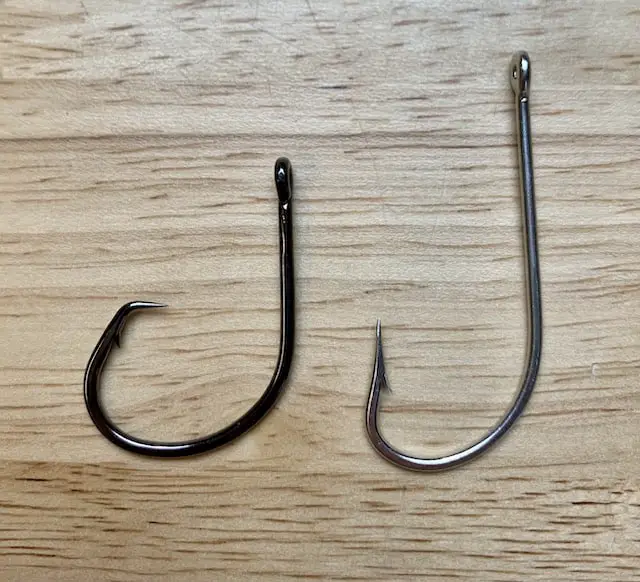Differences between circle hook and J hook in shape and design
A circle hook has an eye, shank, and point, just like most other fishing hooks. The characteristic that distinguishes a circle hook from a J hook is the direction the point points, directly perpendicular to the shaft. A J hook is the exact opposite–the point points directly parallel to the shaft. This difference dramatically affects the way the hook works.
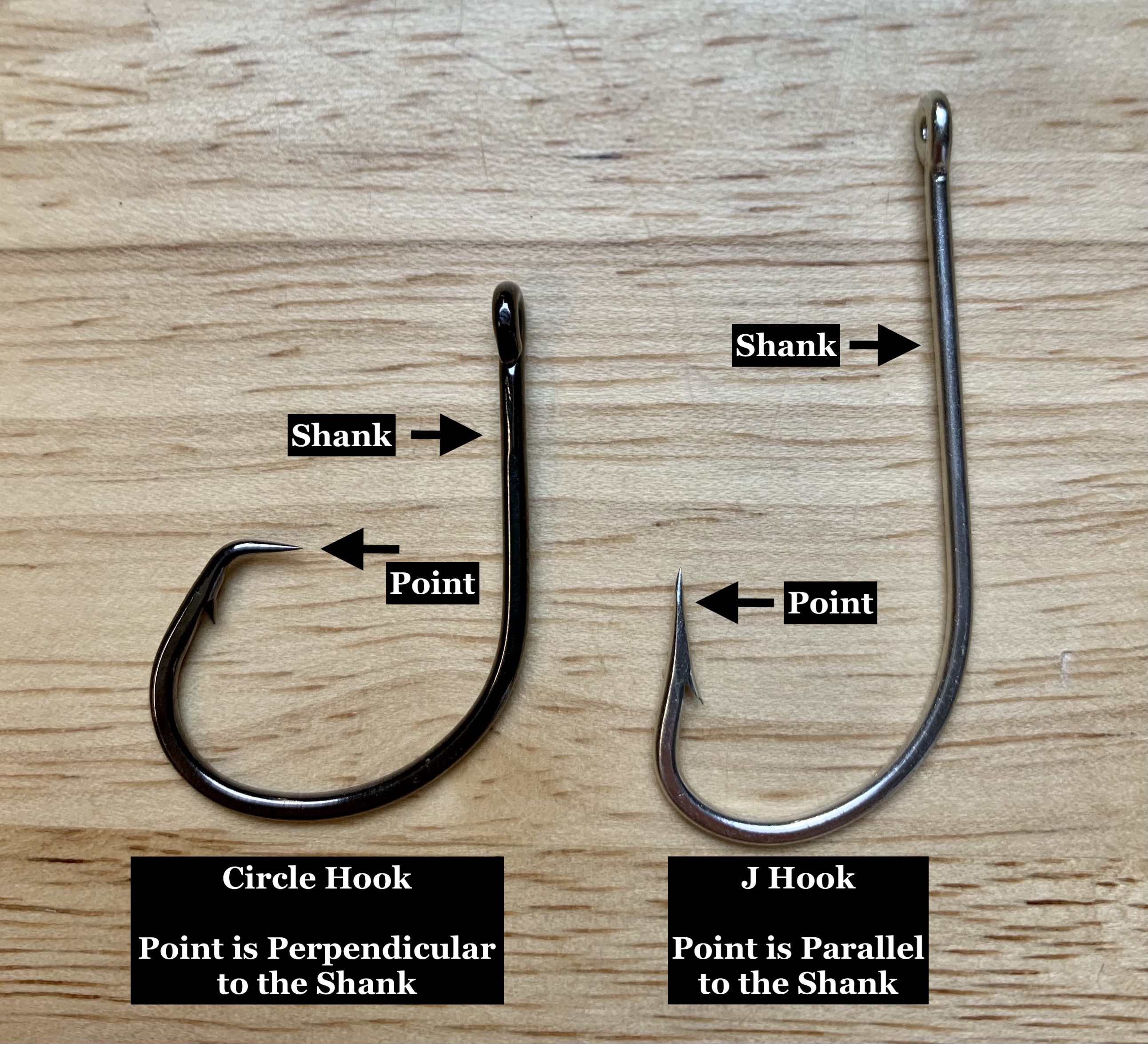
A circle hook works by catching on the fish's mouth just as the fish is turning away after striking the bait. A circle hook sets without having the fisherman consciously “set” the hook. For surf fishing, when rods are usually in a sand spike, a circle hook has a huge advantage by not requiring an active set. The tradeoff is that circle hooks are more difficult to bait because the point is much closer to the shaft. A J hook, on the other hand, has plenty of space between the point and the shaft which makes baiting the hook very easy to do. As far as hooking a fish, J hooks usually hook the fish wherever the fisherman “sets” the hook. This is a more active approach and can be a drawback when surf fishing and also is more likely to harm the fish since the fish will likely swallow the bait and get hooked in the gut.
Circle hooks come in a variety of configurations. You can choose the coating color, such as silver or black chrome, and sometimes even red. Although there are several hook color options, the evidence around which color is best is spotty. After all the fishermen I've talked to, it seems to be mostly personal preference based on the aesthetics of the hook. The photo below shows a variety of circle hooks we found at our local fishing store.
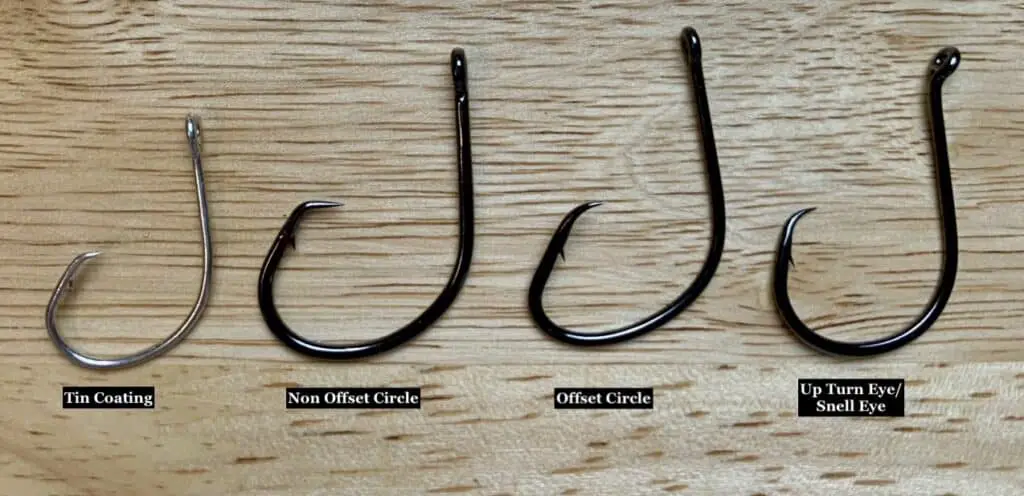
To help understand the difference between an inline hook and an offset hook, we included the image below. You can see that an inline hook keeps the point in alignment with the shaft. The offset hook is intentionally not in alignment with the shaft. Some fishermen say they get better hookups with the offset hooks, but some fishing regulations prohibit the use of them (we'll talk about why later in the article). Inline and offset variations are present in both circle hooks and J hooks.
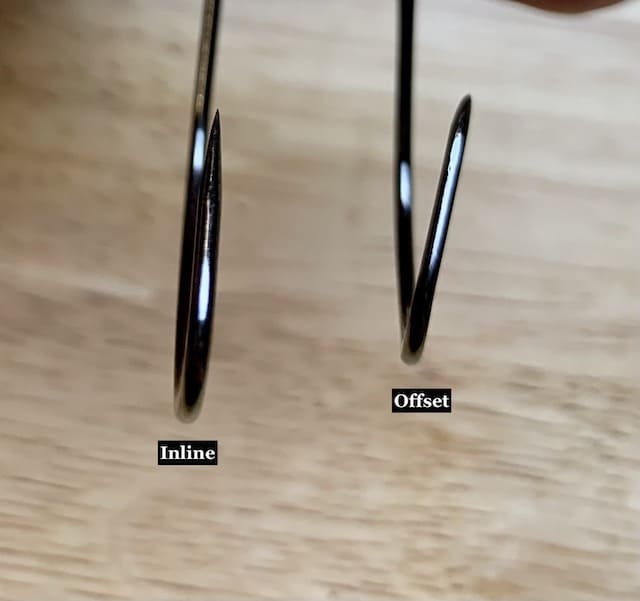
We took a trip to our local tackle shop and also looked through our tackle box and found several variations of J hooks. In the picture below, you can see silver, gold, red, and black chrome coatings. You can also see variations with the length of the shaft, e.g. the O'Shaughnessy hook and the short shank hook. The long shank hooks are good candidates when you're using a long bait, such as a ballyhoo, and you want the hook to come out of the belly. The short shank hook can also be used with a ballyhoo bait, but you'll get the point to exit up near the throat. These differences can help you when targeting different fish, such as a tuna vs a dolphin. In the image below, you can also see several different configurations of the eye. Down turn and up turn eyes are meant for snelled rigs, the Worm eye is usually rigged with an artificial worm bait, and the inline eye is used to replace treble hooks on hard plastic baits. Check out our other article on J hooks to read more detail about these variations.
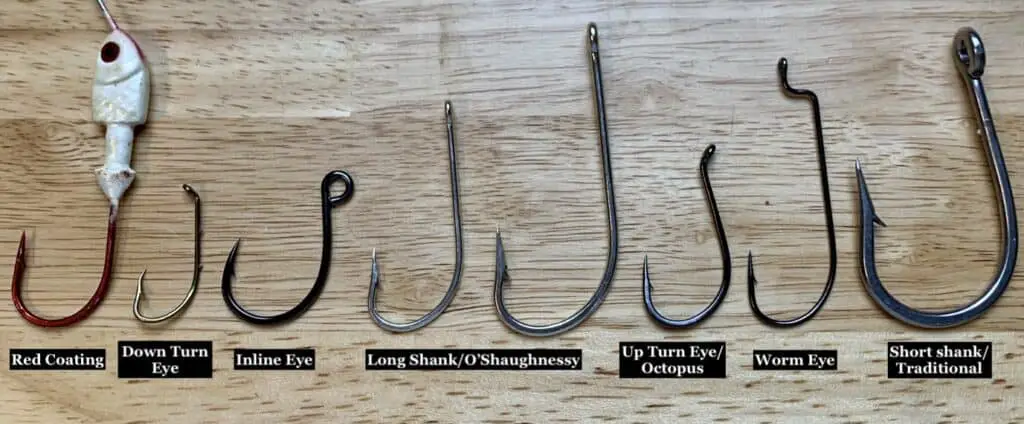
When Should You Use a J Hook Over a Circle Hook?
A J hook is better than a circle hook when you're trolling for aggressive fish species such as Wahoo or Tuna. When you're trolling, you're essentially looking to hook anything that comes near your bait and a J hook is a very reliable hook for it. You may hook the fish in the gut or throat or gills, but if you're planning on keeping the fish, it doesn't matter much where it gets hooked. Some large Mustad J hooks have been dependable for catching strong and fighting fish for decades.
Also, there are some fishermen who enjoy active fishing. That is, when you're holding the rod and waiting to feel the bite of the fish. When the fishermen feels the tug, the yank the rod up and set the hook. This is probably an image you've seen before in movies or on tv. This is active fishing and works very well with a J hook. We recommend checking the rules in your area if you're using the J hook in combination with natural baits as sometimes this is illegal.
When Should You Use a Circle Hook Over a J Hook?
A circle hook is going to be your best option when catch-and-release fishing. A circle hook has a very low likelihood of hooking the fish anywhere other than its mouth, which helps it survive when released back into the water. Its unlikely that you'd be catch-and-release fishing while trolling, so its really not a good choice for trolling. Although we mostly focus on saltwater fishing, a circle hook for catch-and-release fishing in freshwater is also very common. To read more about the best hook for catch-and-release fishing, read our other article Choosing Best Hook for Catch and Release Fishing.
Circle hooks are the best choice when you're passively fishing, such as surf fishing with a few rods in sand spikes. This is because of the way a circle hook works–it catches on the side of a fish's mouth as its turning away after striking your bait and doesn't require the fisherman to yank the rod to penetrate the fish. Doesn't that sound great? Sitting back on the beach, with several rigs out in the water, patiently waiting for one to get bit.
Circle Hook vs J Hook for Fishing with Natural Bait (Live or Dead) Fishing
We've mentioned it a few times now, so let's go ahead and discuss the relevant fishing laws regarding circle hooks. In Florida, the law states that you must use non-offset circle hooks when targeting reef fish species, such as snappers, groupers, amberjack, and others. The actual text from the Florida Wildlife and Conservation website is included below.
Gulf of Mexico: These regulations require the use of a dehooking device when recreationally fishing for reef fish in the Gulf of Mexico. All persons aboard a vessel harvesting reef fish must possess and use non-stainless steel non-offset circle hooks when using natural baits.
Atlantic Ocean: Recreational and commercial fishers are required to use dehooking devices as needed while fishing for reef fish. (New) When fishing for reef fish using hook-and-line with natural baits from a vessel, non-stainless steel, non-offset circle hooks are required N. of 28 degrees N. latitude and non-stainless steel hooks are required S. of 28 degrees N. latitude
Source: Florida Rule 68B-14.005 Reef Fish Gear
The use of circle hooks is required because of the increased chances of fish survival. The hook will most likely end up in the mouth, and if its barbless too, it makes for a quick and easy hook removal. The non-offset requirement is also listed for the same reason. An offset circle hook is likely to hook somewhere undesirable and should be avoided for species that are the subject of conservation. The reason that natural bait is specified here is because fish will likely swallow natural baits. If a J hook were used with natural baits, and the bait was swallowed, you're almost guaranteed to get a gut hook. If a fish swallows a natural bait and a circle hook, the circle hook will be pulled back up out of the fish's stomach and into the mouth and will hook as the fish swims away. Fish are smart enough to realize the difference between natural baits and artificial baits once they strike, so the same rule doesn't exist for artificial baits since the fish probably wouldn't swallow the artificial bait. These laws have been demonstrated to be effective as fish populations have increased for reef fish.
Circle Hook vs J Hook for Fishing with Artificial Baits
A J hook is the way to go when using artificial baits, even if targeting a catch-and-release species. Statistically, the hard plastic bait won't travel past the fish's mouth and therefore cannot hook the fish in a damaging place like its throat, gills, or gut.
Interestingly enough, we actually recommend replacing the standard treble hooks on a hard plastic bait with J hooks instead. This is a new concept for us, but we are enjoying the easier hook removal now! Treble hooks have always been hard to remove, and they take too long to remove, and sometimes I end up hurting the fish even more if i accidentally hook it again in a new spot when trying to remove the treble. A J hook is straightforward to remove since there's only one point!
Circle Hook vs J Hook for Trolling
We recommend a J hook for trolling. You'll likely encounter some aggressive fish whether you're in saltwater or freshwater, and you'll want the security of a J hook. A J hook will hook any fish that bites your bait, regardless of whether the fish continued to swim forward with the bait, or if it turned away. You're also usually going to be taking home the fish you catch while trolling, so there's not much of a need to protect the survivability of the fish. The common rigs to use when trolling, like a ballyhoo rig or a feathered artificial bait, are usually rigged up with a J hook. The only variation is usually the shaft length, so an O'Shaughnessy hook or a traditional short shank J hook.
Circle Hook vs J Hook for Bottom fishing
Whether to use a circle hook or a J hook for bottom fishing really depends on what you're targeting and where you're located. In freshwater applications, you'll see the use of a J hook, or a worm eye hook (reference the earlier photo) with something like a dropshot rig or a carolina rig. These can be very effective in weeds, or around structure, to target several species year round.
In saltwater though, you're usually targeting snapper or grouper. Both of these species are considered reef fish and are subject to the law shared earlier in this article which states that non-offset circle hooks must be used. Don't worry though, circle hooks are just as effective at hookups, and some data even suggests they're superior for hookups.
Circle Hook vs J Hook for Surf Fishing
We swear by circle hooks when surf fishing. The ideal scenario for us when surf fishing is sitting back in a chair, drinking coffee if its morning, or beer if its afternoon, watching the kids play in the sand and waiting on the tip of the rod to flicker. We've usually got 3 sand spikes spread out with rods out there and even the kids enjoy watching for the rods to show signs of a bite. This method of fishing is really only effective with a circle hook since it doesn't require a jerk of the rod to set the hook.
I hope this post was informative for you! Tight lines, y'all!

